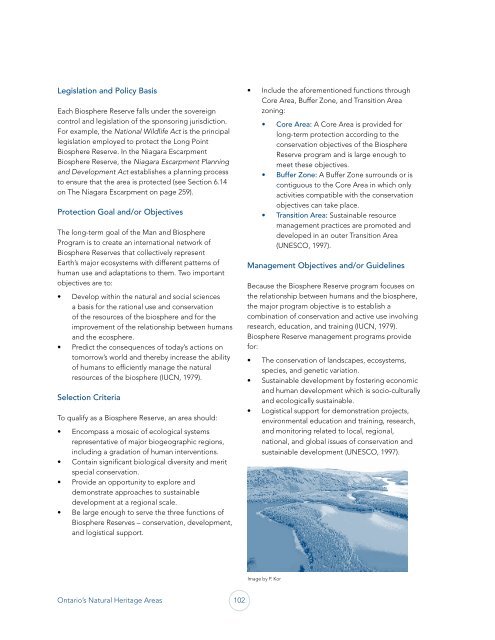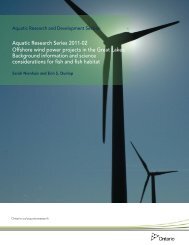Ontario's Natural Heritage Areas - Ministry of Natural Resources
Ontario's Natural Heritage Areas - Ministry of Natural Resources
Ontario's Natural Heritage Areas - Ministry of Natural Resources
You also want an ePaper? Increase the reach of your titles
YUMPU automatically turns print PDFs into web optimized ePapers that Google loves.
Legislation and Policy Basis<br />
Each Biosphere Reserve falls under the sovereign<br />
control and legislation <strong>of</strong> the sponsoring jurisdiction.<br />
For example, the National Wildlife Act is the principal<br />
legislation employed to protect the Long Point<br />
Biosphere Reserve. In the Niagara Escarpment<br />
Biosphere Reserve, the Niagara Escarpment Planning<br />
and Development Act establishes a planning process<br />
to ensure that the area is protected (see Section 6.14<br />
on The Niagara Escarpment on page 259).<br />
Protection Goal and/or Objectives<br />
The long-term goal <strong>of</strong> the Man and Biosphere<br />
Program is to create an international network <strong>of</strong><br />
Biosphere Reserves that collectively represent<br />
Earth’s major ecosystems with different patterns <strong>of</strong><br />
human use and adaptations to them. Two important<br />
objectives are to:<br />
• Develop within the natural and social sciences<br />
a basis for the rational use and conservation<br />
<strong>of</strong> the resources <strong>of</strong> the biosphere and for the<br />
improvement <strong>of</strong> the relationship between humans<br />
and the ecosphere.<br />
• Predict the consequences <strong>of</strong> today’s actions on<br />
tomorrow’s world and thereby increase the ability<br />
<strong>of</strong> humans to efficiently manage the natural<br />
resources <strong>of</strong> the biosphere (IUCN, 1979).<br />
Selection Criteria<br />
To qualify as a Biosphere Reserve, an area should:<br />
• Encompass a mosaic <strong>of</strong> ecological systems<br />
representative <strong>of</strong> major biogeographic regions,<br />
including a gradation <strong>of</strong> human interventions.<br />
• Contain significant biological diversity and merit<br />
special conservation.<br />
• Provide an opportunity to explore and<br />
demonstrate approaches to sustainable<br />
development at a regional scale.<br />
• Be large enough to serve the three functions <strong>of</strong><br />
Biosphere Reserves – conservation, development,<br />
and logistical support.<br />
Ontario’s <strong>Natural</strong> <strong>Heritage</strong> <strong>Areas</strong> 102<br />
• Include the aforementioned functions through<br />
Core Area, Buffer Zone, and Transition Area<br />
zoning:<br />
• Core Area: A Core Area is provided for<br />
long-term protection according to the<br />
conservation objectives <strong>of</strong> the Biosphere<br />
Reserve program and is large enough to<br />
meet these objectives.<br />
• Buffer Zone: A Buffer Zone surrounds or is<br />
contiguous to the Core Area in which only<br />
activities compatible with the conservation<br />
objectives can take place.<br />
• Transition Area: Sustainable resource<br />
management practices are promoted and<br />
developed in an outer Transition Area<br />
(UNESCO, 1997).<br />
Management Objectives and/or Guidelines<br />
Because the Biosphere Reserve program focuses on<br />
the relationship between humans and the biosphere,<br />
the major program objective is to establish a<br />
combination <strong>of</strong> conservation and active use involving<br />
research, education, and training (IUCN, 1979).<br />
Biosphere Reserve management programs provide<br />
for:<br />
• The conservation <strong>of</strong> landscapes, ecosystems,<br />
species, and genetic variation.<br />
• Sustainable development by fostering economic<br />
and human development which is socio-culturally<br />
and ecologically sustainable.<br />
• Logistical support for demonstration projects,<br />
environmental education and training, research,<br />
and monitoring related to local, regional,<br />
national, and global issues <strong>of</strong> conservation and<br />
sustainable development (UNESCO, 1997).<br />
Image by P. Kor

















